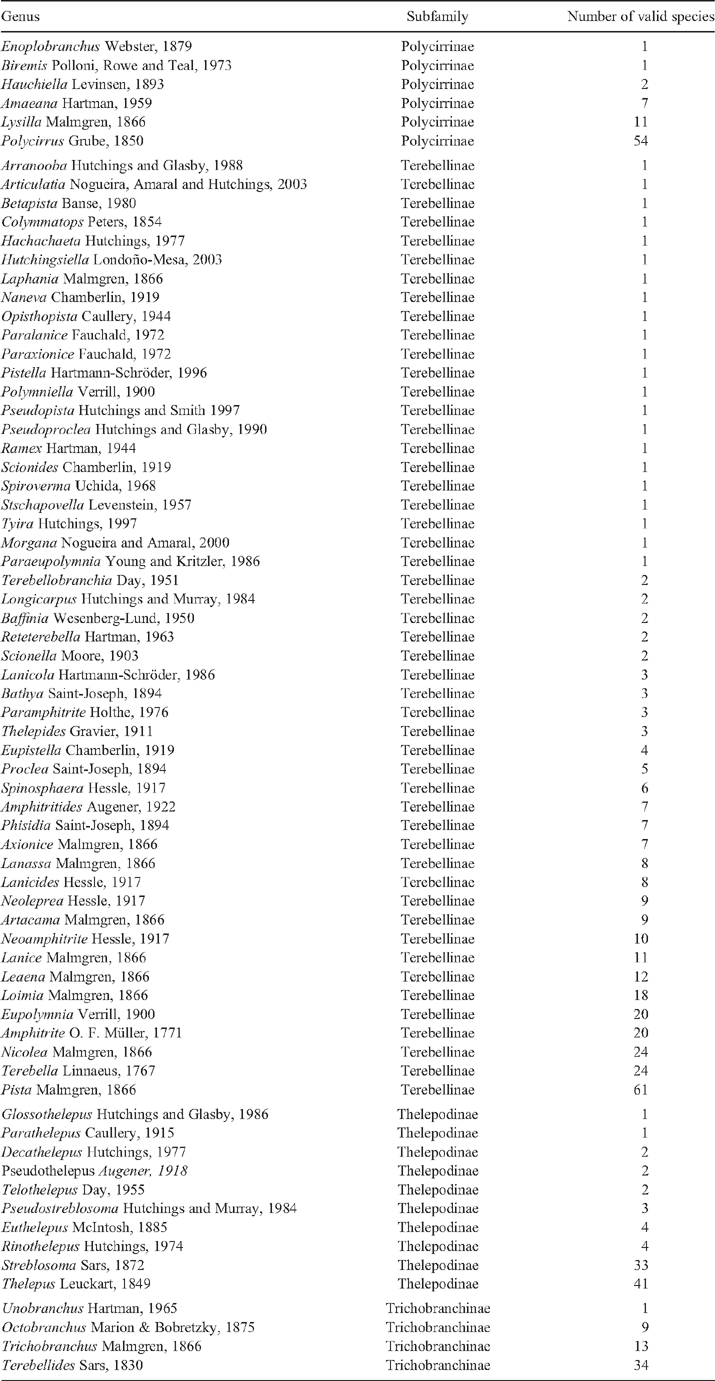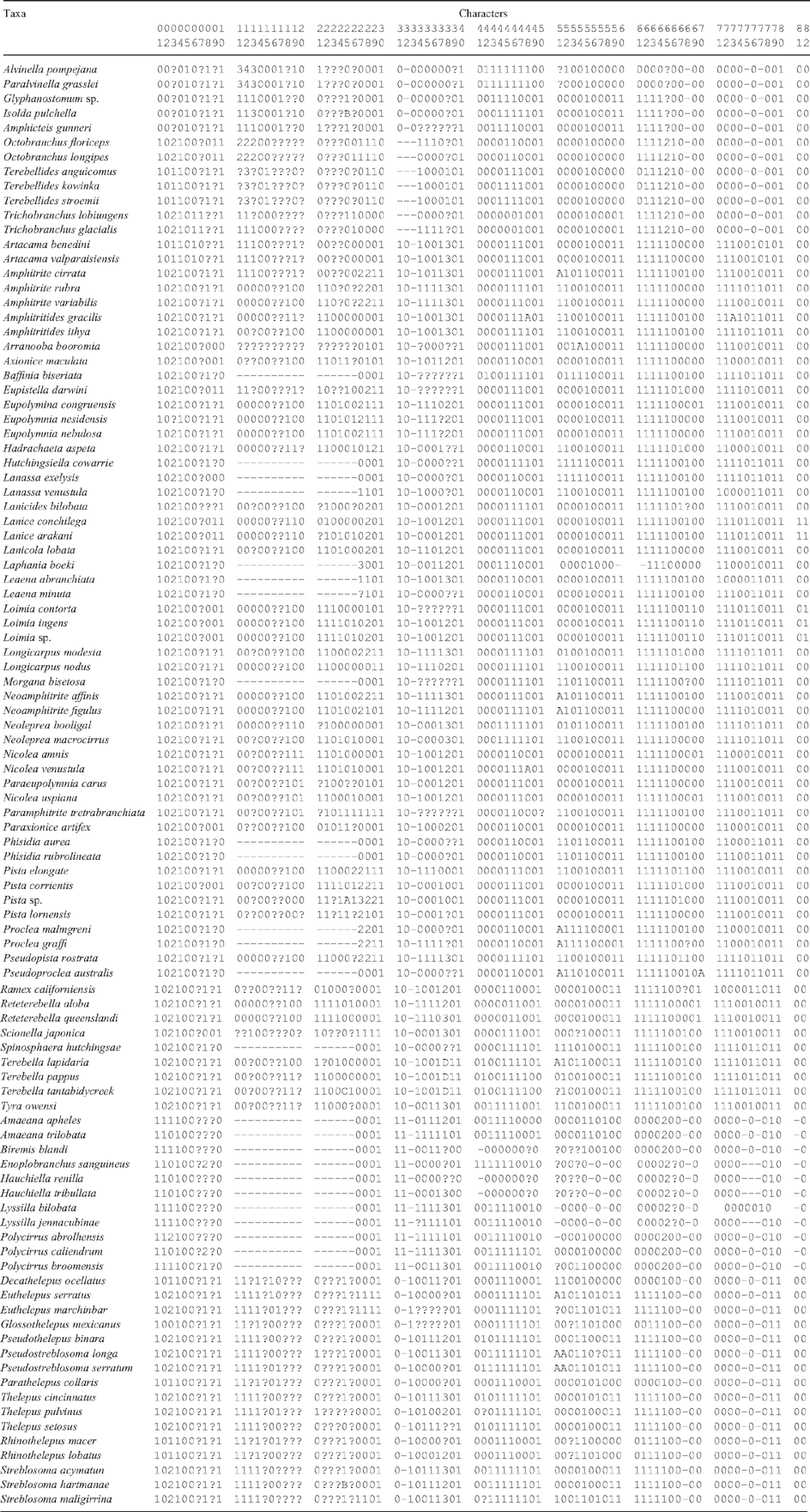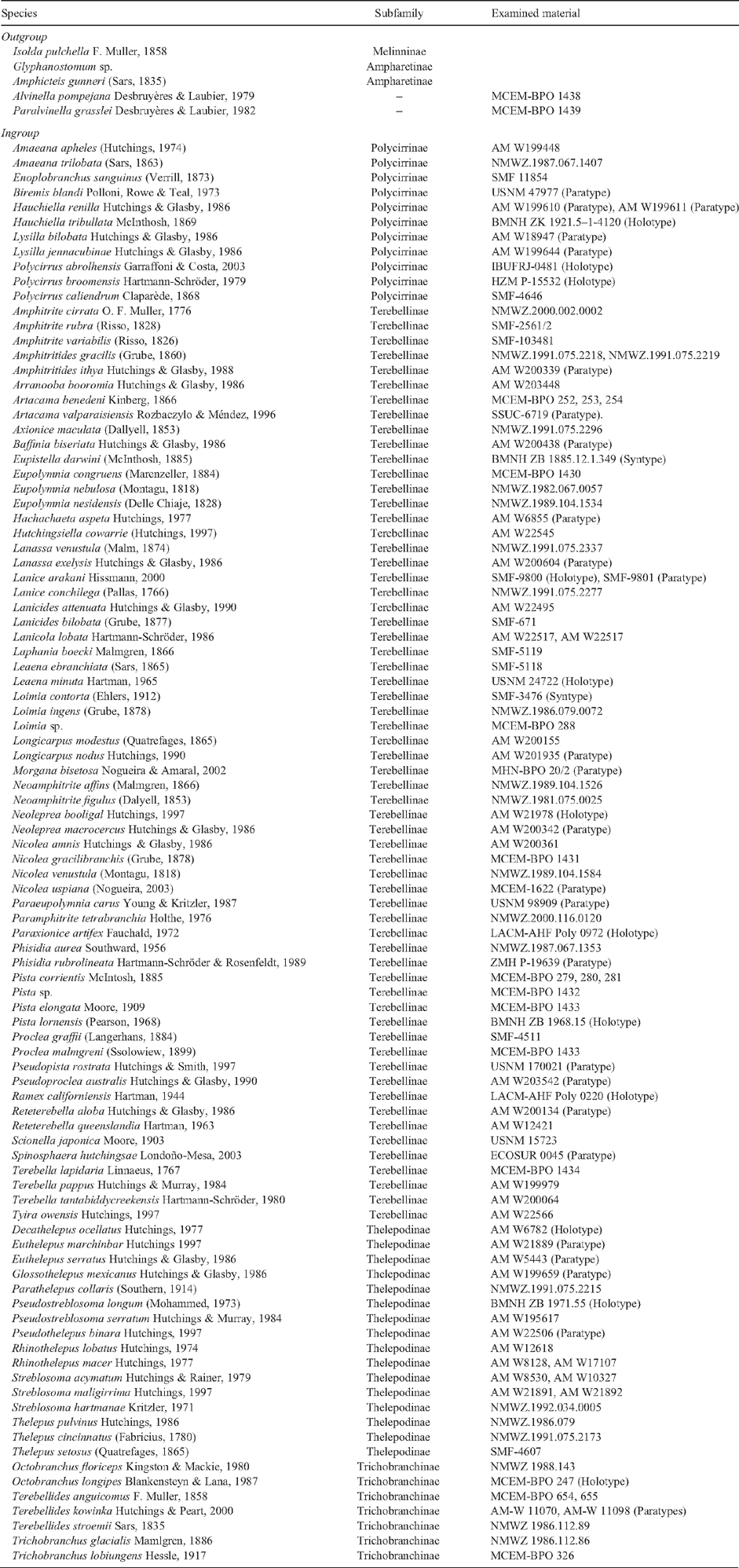Phylogenetic relationships within the Terebellidae (Polychaeta : Terebellida) based on morphological characters
André R. S. Garraffoni A B C and Paulo C. Lana AA Centro de Estudos do Mar, Universidade Federal do Paraná, Av. Beira Mar s/n, CP 50002, Pontal do Paraná, PR 83255-000, Brazil.
B Present address: Universidade Federal dos Vales do Jequitinhonha e Mucuri, Departamento de Ciências Biológicas, Campus II, Rodovia BR-367, CEP: 39.100-000, Diamantina, MG, Brazil.
C Corresponding author. Email: garrafoni@gmail.com
Invertebrate Systematics 22(6) 605-626 https://doi.org/10.1071/IS07006
Submitted: 16 March 2007 Accepted: 17 October 2008 Published: 22 December 2008
Abstract
Most of the recognised genera in Terebellidae lack phylogenetic support because their current diagnoses are based on homoplastic or plesiomorphic features. To address this problem, the phylogenetic relationships of terebellid genera were studied using a morphology-based parsimony analysis of 94 species, with members of the Ampharetidae and Alvinellidae as outgroups. The monophyly of the Terebellidae is supported by the presence of a prostomium shaped as a dorsal ridge-like structure, the prostomial buccal tentacles not retractable into the mouth and the ventral glandular areas having distinct pads. The subfamilies Polycirrinae, Terebellinae and Trichobranchinae are monophyletic. Species of Trichobranchinae form a clade within the Terebellidae, which provides further evidence to support its subfamily status. The lack of evidence to support Thelepodinae reinforces previous statements that this group is not monophyletic.
Acknowledgements
We thank many colleagues who provided generous help and access to museum collections and facilities: Penny Berents and Pat Hutchings (Australian Museum), Dieter Fiege (Senckenberg Museum), Leslie H. Harris (Los Angeles County Museum), Andrew Mackie (Museum of Wales), Emma Sherlock (British Museum), Paulo Paiva (Universidade Federal do Rio de Janeiro), Nicolas Rozbaczylo (Pontifícia Universidad Católica de Chile), Kristian Fauchald (Smithsonian Institution), Angelika Brandt (Zoologisches Institut und Zoologisches Museum der Universität), Cecilia Amaral (Museu de História Natural de Campinas), Mario H. Londoño-Mesa (ECOSUR). Cinthya Santos, Walter Boeger, Gabriel Mello, Cecília Amaral, João Nogueira, Anete Lourenço, three anonymous referees and Camilla Myers are gratefully acknowledged for offering suggestions that greatly improved the paper. Pedro Martínez provided working facilities to the first author at the Senckenberg Institute (Wilhelmshaven, Germany), where part of the material used in the present study was examined. Dieter Fiege helped us with the partial translation of Grube’s papers. This research was supported by a grant provided to the first author by the Brazilian funding agencies CAPES, FAPESP (05-59809-7), and the Germany agency DAAD.
Almeida W. O.,
Christoffersen M. L.,
Amorim D. S.,
Garraffoni A. R. S., Silva G. S.
(2003) Polychaeta, Annelida, and Articulata are not monophyletic: articulating the Metameria (Metazoa, Coelomata). Revista Brasileira de Zoologia 20, 23–57.
| Crossref | GoogleScholarGoogle Scholar |
(Cornell University: Ithaca, NY, USA.)
Nixon K. C., Carpenter J. M.
(1993) On outgroups. Cladistics 9, 413–426.
| Crossref | GoogleScholarGoogle Scholar |

Nixon K. C., Davis J. I.
(1991) Polymorphic taxa, missing values and cladistic analysis. Cladistics 7, 233–241.
| Crossref | GoogleScholarGoogle Scholar |

Nogueira J. M. M.
(2003) A new species of Paraeupolymnia Young and Kritzler 1986 (Polychaeta: Terebellidae: Terebellinae) from Brazil. Scientia Marina 67, 403–411.

Nogueira J. M. M., Alves T. M.
(2006) Two new terebellid polychaetes (Polychaeta: Terebellidae) from the state of São Paulo, southeastern Brazil. Zootaxa 1205, 31–54.

Nogueira J. M. M., Amaral A. C. Z.
(2001) New terebellids (Polychaeta: Terebellidae) living in colonies of a stony coral in the state of São Paulo, Brazil. Proceedings of the Biological Society of Washington 114, 285–296.

Nogueira J. M. M., Hutchings P. A.
(2007) New species of terebellid polychaetes (Polychaeta: Terebellidae) from Australia. Zootaxa 1473, 1–24.

Nogueira J. M. M.,
Hutchings P. A., Amaral A. C. Z.
(2003)
Articulatia, a new genus of Terebellinae (Polychaeta: Terebellidae) living in Brazilian corals. Journal of the Marine Association of the United Kingdom 83, 761–770.
| Crossref | GoogleScholarGoogle Scholar |

Nogueira J. M. M.,
Garraffoni A. R. S., Alves T. M.
(2004) A new species of Streblosoma Sars, 1872 (Polychaeta, Terebellidae, Thelepodinae) from Brazil, with comment on Streblosoma oligobranchiatum Nogueira & Amaral, 2001. Beaufortia 54, 93–103.

Patterson C., Smith A. B.
(1987) Is periodicity of mass extinctions a taxonomic artifact? Nature 330, 248–251.
| Crossref | GoogleScholarGoogle Scholar |

Patterson C., Smith A. B.
(1989) Periodicity in extinction: the role of systematics. Ecology 70, 802–811.
| Crossref | GoogleScholarGoogle Scholar |

Pearson T. H.
(1969)
Scionella lornensis sp. nov., a new terebellid (Polychaeta: Annelida) from the west coast of Scotland, with notes on the genus Scionella Moore, and a key to the genera of the Terebellidae recorded from European waters. Journal of Natural History 3, 509–516.
| Crossref | GoogleScholarGoogle Scholar |

Platnick N. I.
(1976) Are monotypy genera possible? Systematic Zoology 25, 198–199.
| Crossref | GoogleScholarGoogle Scholar |

Platnick N. I.
(1977) Monotypy and the origin of higher taxa: a reply to E. O. Wiley. Systematic Zoology 26, 355–357.
| Crossref | GoogleScholarGoogle Scholar |

Pleijel F.
(1995) On character coding for phylogeny reconstruction. Cladistics 11, 309–315.
| Crossref | GoogleScholarGoogle Scholar |

Prendini L.
(2001) Species or supraspecific taxa as terminals in cladistic analysis? Groundplans versus exemplars revisited. Systematic Biology 50, 290–300.
| Crossref | GoogleScholarGoogle Scholar |
CAS |
PubMed |

Rouse G. W., Fauchald K.
(1997) Cladistics and polychaetes. Zoologica Scripta 26, 269–301.

Rouse G. W., McHugh D.
(1994) Ultrastructure of spermatids and spermatozoa in Ramex califoniensis a and Nicolea zostericola (Terebellidae: Polychaeta). Ophelia 39, 225–238.

Rousset V.,
Rouse G. W.,
Féral J. P.,
Desbruyères D., Pleijel F.
(2003) Molecular and morphological evidence of Alvinellidae relationships (Terebelliformia, Polychaeta, Annelida). Zoologica Scripta 32, 185–197.
| Crossref | GoogleScholarGoogle Scholar |

Rozbaczylo N., Méndez M. A.
(1996)
Artacama valparaisiensis, a new species of Terebellidae (Annelida: Polychaeta) from subtidal soft bottoms of Valparaiso Bay, Chile. Proceedings of the Biological Society of Washington 109, 138–142.

Saphronova M. A.
(1991) Redescription of some species of Scionella Moore, 1903, with a review of the genus and comments on some species of Pista Malmgren, 1866 (Polychaeta: Terebellidae). Ophelia 5, 239–247.

Solis-Weiss V.,
Fauchald K., Blankensteyn A.
(1991) Trichobranchidae (Polychaeta) from shallow warm water areas in the Western Atlantic Ocean. Proceedings of the Biological Society of Washington 104, 147–158.

Tourtellotte G., Kritzler H.
(1988)
Scionella papillosa, a new species of Polycheata (Polychaeta: Terebellidae) from the southwest Florida continental shelf. Proceedings of the Biological Society of Washington 101, 79–82.

Wilson D. P.
(1928) Post-larval development of Loimia medusa Sav. Journal of the Marine Association of the United Kingdom 15, 129–149.

Yeates D. K.
(1995) Groundplans and exemplars: paths to the tree of life. Cladistics 11, 343–357.
| Crossref | GoogleScholarGoogle Scholar |

Zhadan A. E., Tzetlin B.
(2003) Comparative study of the diaphragm (gular membrane) in Terebelliformia (Polychaeta, Annellida). Hydrobiologia 496, 269–278.
| Crossref | GoogleScholarGoogle Scholar |


|

|



